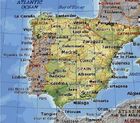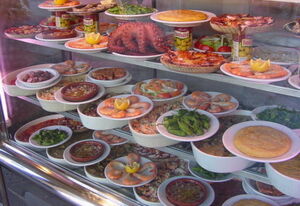Browse All Spanish Recipes: Spanish Appetizers | Spanish Soups | Spanish Salads | Spanish Vegetarian | Spanish Meat Dishes | Spanish Snacks | Spanish Desserts

|
This article is a stub! This article doesn't contain enough information. If you know anything about Spanish Cuisine, please add to this article!
|
Spain - Cooking and Food[]
Overview of Spanish Cuisine History[]
Because of Spain’s extensive history and many cultural influences that have affected its evolution along the course of time, the eating habits and recipes have also been influenced in a variety of forms, leading to a complex cuisine that satisfies all tastes. With literally thousands of recipes, the Spanish cuisine beneficiated since ancient times of a series of products and merchandising goods that were transported across the Mediterranean region. The Wheat was one of such basic elements for cooking, and was brought from Aquitaine in the north of the peninsula in same period when mushrooms had become popular in the region. Spain is a well know country for its tasty wines that go very well with different meals. Wine and the viticulture were first introduced to the peninsula by the Greeks at the time when the Roman Empire was already practicing the viticulture and wine was a popular thing in their region. Spain is the country where Sangria had developed as an alternative to a simple grape-wine. Sangria is actually a punch wine that is made differently according to the region where it is found.
olive oil is a major basis for cooking, even though condiments and spices were not a defined basic element of the ancient Spanish cuisine, thing kept in today’s Spanish cuisine as well.
One can find different varieties of food in different regions of Spain. The best-known recipes of Barcelona are stews, as La escudella i carn d'olla, made of vegetables, rice, noodles and potatoes, Cocido con judias blancas, of Butifarra (a typical regional Sausage), Pilota (a preparation of Beef), bread, eggs and white beans, Faves a la catalana, Botifarra amb monjetes and Arroz a la cazuela, a dish similar to the famous "Paella Valenciana".
Fish specialities are "Zarzuela", a dish made of Cuttlefish, mussels and prawn, and "La Opera", its more luxurious version added with lobster.
Typical desserts are crema Catalana, Mel i mato (of curds and honey), and the Postre del Musico ("dessert of the musician") with pine-kernels and raisins. When it comes to the wines, red wines from Peralda, Alella, Priorat and Tarragona, white wines from Penedés and of course the famous Cava (sparkling wine). In Santiago, most typical is fish, which is available in extraordinary quality. The Saint Jacob's Shell, Viera and Pulpo á la Gallega, Cuttlefish prepared with paprika are the first choice of the visitors. Another well-known dish is Empanada Gallega, a pie of fish, meat or vegetables. When talking about sweets, Tarta Compostelana, a tart of almonds, is most famous. The wines specially Ribeiro is very young and fresh. Other food one can not forget to try are Fefiñanes, Betanzos, Rosal, Valdeorras, Ulla and Amandi.
In Burgos it is the fresh cheese with slight goat-milk-flavor, called "Queso de Burgos", considered to be most popular food throughout the Spain. Other delicious foods are Roasted Lamb, chopped Pork, blood pudding, red beans (called Ibeas) and hotpot.
Some of the well known recipe one can enjoy in any of the spannish restaurant are: A Two Course rice - (Arroz Abanda), Aceitunas Con Mojo, Aioli Sauce (Spain), Ajoblanco, Albondigas, Albondigas (Meatballs), All-i-Oli with egg Yolks, All-i-Oli with Mustard, All-i-Oli with tomatoes Sauces, almond Cake - (Tarta De Almendras), almond Cookies i - (Almendrados), almond Cookies ii - (Almendrados), almond Spongecake - (Bizcocho De Almendras), Anchovies, Andalusian Chicken or Pollo Andaluz with rice and Peas, Catalan Peasant Soup - (Escudella De Pages), Catalan Roast - (Rustido a La Catalana), Catalan Salad - (Ensalada Catalana), Catalan tomato Bread - (Pa Amb Tomaquet) etc.
Cuisines of Spain[]

Map of Spain - Click to enlarge
The variety of dishes that Spain’s cuisine has is reflected differently in each of Spain’s region. In the north part of Spain, a meat-based diet, rich in animal fats is more likely to be found, while as in the south part, a Mediterranean influence is noticeable in the specific dishes cooked in these regions. In the provinces of Cáceres and Badajoz, region also called Extremadura, the main characteristic dish is the olla podrida, which is basically a stew made of Bacon, fowl, Ham and all kind of meats and vegetables. Cheeses, including the torta Del casar, and the pitarra wine are also know for this region. In the Navarra region, the stews are also a common thing, especially vegetable ones, and also in these parts of the country there can be found a specific kind of peppers, the piquillo, which are usually stuffed with meat and cooked in the oven. La Rioja region is very well known all over the world for the Rioja wines. Also, vegetable soups are a common thing in this region. Sangria is a wine punch that can be found in all Spain’s parts. In southern Spain, sangría is also called zurra and is prepared from peaches or nectarines. In the Madrid region of Spain, the most common dish is the Cocido Madrileno, which is a Chickpea stew that is served with wines from Navalcarnero.
Spanish Food Glossary[]
Finding the ingredients for a Spanish Recipe is not so easy when you do not know the names of the ingredients. Take time to make a list of ingredients and the name they may be found under at the Local Markets.
- Check out the Spanish Food Glossary
Preparation Methods for Spanish Cooking[]
Preparing a traditional Spanish dish doesn’t imply you to use specific condiments or secret ingredients. The secret is all in the mixture of vegetables and the kind of meats you want to put in the food. The Spanish cuisine relies on a variety of methods in which you can cook the same dish. Depending on the region of the country, you can meet people that use spicier condiments to prepare the same paella, that others will prepare it only with saffron. In all cases, a basic rule in food preparation is the mixture of meats in the same dish. Stews are one of the most important dishes in the Spanish cuisine, and when preparing a delicious original stew, you must use your imagination, as well as, good cooking skills.
Special Equipment for Spanish Cooking[]
For a Spanish classic meal, you will definitely need a lot of pots and serving spoons, spatulas, forks, turners, scrapers and tongs. Also, deep frying pans are a must. You need them to cook all kind of meat for those special Spanish stews. Deep serving dishes are required for the Spanish soups. You need to consider cover lids and insulated food carriers to keep the temperature of the food constant, if you plan on serving the dishes at their optimized temperature. Because of the fact that the stews and the soups get cold really fast, and because you have to put the meats inside the boiling pans at the right temperature, a thermometer would be a wise choice for you to acquire in your Spanish kitchen. Most Spanish dishes don’t require you to purchase any special tools. However, having a coffee grinder helps with roasting and grinding spices and maximizes their volatile oils, which, in turn, provides your food with more flavor.
Spanish Food Traditions and Festivals[]
Spain is known worldwide for its festivals and fiestas, most of which celebrate life. All of the festivals include flamenco dances in the streets and wine tasting, and there is even a specific festival, the Jerez's sherry festival, that celebrates the grapes and the blessing of the wine. It takes place on the first Saturday of September of every year, and Spanish people get to taste more than hundred types of wines. There is a seafood festival in O'Grove, one that celebrates all types of seafood, and represents of course the tasting of all fish related dishes. Because of the Mediterranean influences that Spain has suffered along the course of time, fish is an important element in the regular diet, and it can be cooked in many different ways by different chefs. There is also a paella festival that takes place in Sueca, and is a celebration of the paella dish. People all over the country prepare their own unique recipe, according to the influences they had in their native places. The garnish that goes with the basic paella is the most variable one of all and you can see meat-based garnishes, or on the contrary a steamed vegetable one.
People in Spanish Food[]
- Are you into Spanish Cooking and would like to be interviewed?
Spanish chefs are the most passionate ones in all cuisines, and some of them are well known worldwide in all food contests that take place annually. The many recipes and even more methods of preparing special traditional Spanish meals are basically due to the feeling that a chef adds to the cooking process. Because of the volcanic temperament of the Latin people, Spanish people involved in the specific cooking process, put their feelings and their personal touch in everything they create. The originality of each recipe is given by the creativity of the chef.
Spanish people are also gourmands, enjoying the eating process very much. Unlike many other countries in the world, the Spanish people like to cook their own meals at home, like to be personally involved in the process. Whenever you serve a dish at a local restaurant, you will definitely notice the personal not added by the people that have prepared your meal, and you will also notice the passion with which they will cater whatever they have cooked for you, making you fell welcomed around them.

